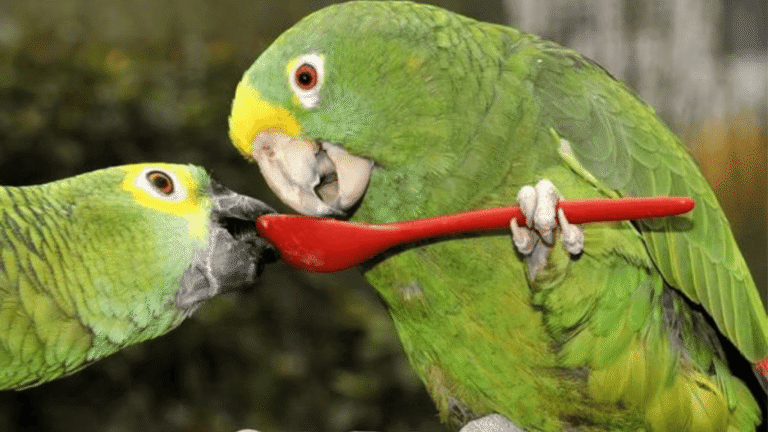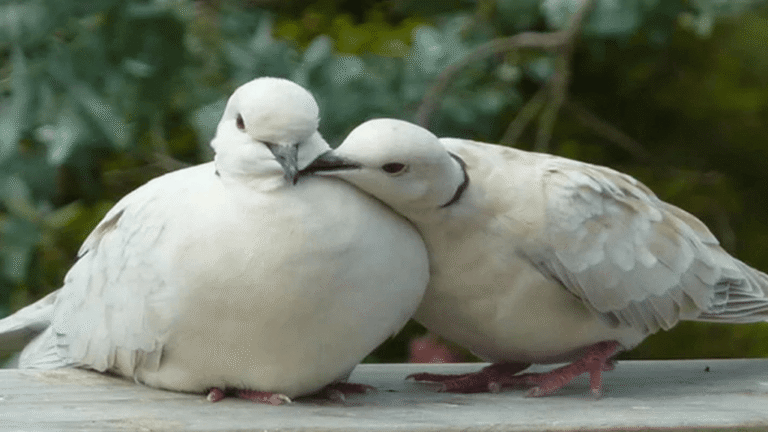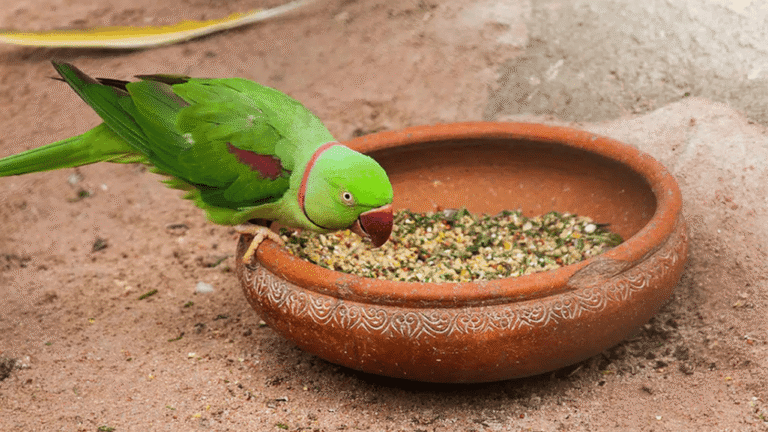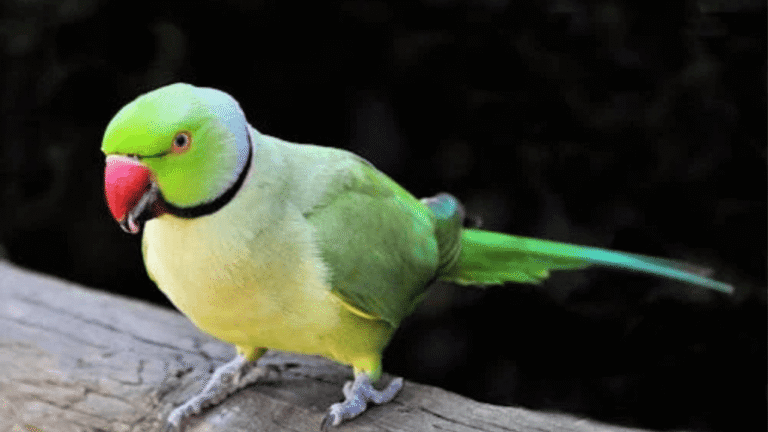The Rock Parrot, also known as the Rock Elegant Parakeet, is a cute and chubby bird that originates from Australia. It belongs to the Grass Parrot family and is primarily found in coastal dune areas and rocky islands. This article will provide expert tips on the care of Rock Parrots, including their habitat, diet, behavior, and conservation status.
Key Takeaways:
- The Rock Parrot is native to the rocky shores of southern and southwestern Australia.
- Their diet includes fruits, seeds, shrubs, salt-tolerant plants, rushes, and grasses.
- Rock Parrots are social birds and enjoy making flights and engaging in playful behavior.
- The species is currently classified as a species of least concern by the IUCN, but their population numbers in the wild are low.
- Providing suitable care and conservation efforts are essential for the continued survival of Rock Parrots.
Habitat of the Rock Parrot
The Rock Parrot, also known as the Rock Elegant Parakeet, is a delightful bird native to the rocky shores of southern and southwestern Australia. These charming birds can be found in two main regions: Western Australia and South Australia. In Western Australia, they inhabit the area from Arid National Park to Geraldton, while in South Australia, they can be seen from Kingston to Ceduna.
Rock Parrots have a strong affinity for coastal areas, particularly coastal dune areas and rocky islands. These habitats provide them with the perfect environment for nesting, foraging, and seeking shelter. Their natural surroundings consist of rugged coastlines, where they can find an abundance of food and suitable nesting sites.
Coastal dune areas are characterized by extensive sand dunes and low-growing vegetation, including shrubs, grasses, and salt-tolerant plants. These areas offer ample cover for the Rock Parrots, helping them blend into their surroundings and evade predators. The proximity to the ocean also provides them with a diverse range of food sources, including marine vegetation and coastal plant species.
In addition to coastal dune areas, rocky islands are another preferred habitat of the Rock Parrot. These islands provide safe breeding grounds and nesting sites, as the rocky crevices and burrows offer protection from predators and inclement weather.
Threats to the Rock Parrot’s Habitat
The Rock Parrot’s habitat is under constant threat due to human activities, including urbanization and coastal development. As coastal areas become developed for residential or commercial purposes, the natural habitats of these birds are destroyed or significantly altered. The removal of coastal vegetation and the disruption of their nesting sites endanger the Rock Parrot population.
“The Rock Parrot’s unique coastal habitat is fragile and sensitive to human interference. It is crucial that we take steps to protect these areas and preserve the natural environment for the long-term survival of this beautiful bird species.”
Efforts are underway to raise awareness about the importance of preserving the Rock Parrot’s habitat. Conservation organizations, government agencies, and local communities are collaborating to implement measures that will safeguard these coastal areas and promote sustainable development practices.
Conservation Status
The Rock Parrot is currently classified as a species of least concern by the International Union for Conservation of Nature (IUCN). While this designation indicates that the population is relatively stable, it is crucial to continue monitoring and protecting the Rock Parrot’s habitat to ensure their continued survival in the wild.
| Conservation Status | Classification |
|---|---|
| IUCN Red List Status | Least Concern |
Diet of the Rock Parrot
The Rock Parrot is an omnivorous bird with a diverse diet that consists of fruits, seeds, shrubs, salt-tolerant plants, rushes, and grasses. In the wild, these parrots forage for food in forested areas, gardens, and vacant spaces, making the most of the varied plant life found in their habitat.
In captivity, it is crucial to provide Rock Parrots with a well-balanced diet that mimics their natural food sources. A diet rich in nutrients will help them maintain optimal health and prevent obesity and other related health issues. Here is a breakdown of the key components of their diet:
- Seeds: Rock Parrots consume a variety of seeds, including grass seeds and native plant seeds. These seeds provide essential nutrients and energy for their daily activities. It is important to provide a mix of seeds to ensure a varied diet.
- Fruits: Fresh fruits, such as apples, berries, and melons, are a great source of vitamins and minerals for Rock Parrots. They enjoy biting into juicy fruits and relishing the flavors. Fruits also add diversity to their diet.
- Vegetables: Offer a selection of fresh vegetables, such as leafy greens, carrots, and bell peppers. Vegetables provide important vitamins and minerals, as well as dietary fiber. These colorful additions make the diet more appealing.
- Supplements: Consider providing calcium and vitamin supplements to ensure complete nutrition. These supplements can be sprinkled on the bird’s food or offered in the form of cuttlebones or mineral blocks.
Note: Avoid giving Rock Parrots foods that are high in fat or sugar, as these can lead to health problems. Examples of foods to avoid include chocolate, fried snacks, and sugary treats.
Offering a variety of foods is essential to meet the nutritional needs of Rock Parrots. Use a combination of seeds, fruits, and vegetables to ensure a balanced and healthy diet for these beautiful birds.
Feeding Tips:
“Providing a balanced diet is the key to ensuring the optimal health and happiness of Rock Parrots. Here are a few feeding tips to consider:
- Monitor portion sizes to avoid overfeeding or underfeeding.
- Offer fresh food daily and remove any uneaten portions to maintain hygiene.
- Introduce new foods gradually to avoid digestive issues.
- Provide clean, freshwater at all times.
- Consult with an avian veterinarian for advice on specific dietary requirements.”
Recommended Diet Plan:
| Food Group | Portion Size |
|---|---|
| Seeds (variety) | 1-2 tablespoons |
| Fresh fruits (assorted) | 1-2 tablespoons |
| Fresh vegetables (variety) | 1-2 tablespoons |
| Calcium supplement | As recommended by a veterinarian |
Note: Adjust portion sizes according to the size, age, and activity level of your Rock Parrot. Observe their behavior and consult with an avian veterinarian to ensure a suitable diet plan.
Behavior of the Rock Parrot
The Rock Parrot is known for its calm and friendly nature. Unlike some other bird species, Rock Parrots are not loud or noisy. They typically remain quiet and calm, creating a peaceful environment. These social birds are often found in pairs or small groups, enjoying each other’s company.
One of the fascinating behaviors of Rock Parrots is their love for making flights together. They engage in playful behavior, soaring through the sky in synchronized movements. These flights not only provide them with exercise but also strengthen their social bonds.
Rock Parrots are relatively easy to tame, making them delightful companions. They form strong bonds with their human caregivers and can become quite affectionate. These intelligent birds enjoy interacting with their owners, displaying their playful antics and curious nature.
Regular social interaction is vital for the well-being of Rock Parrots. They thrive on human companionship and require mental stimulation to stay happy and healthy. Playing games, providing toys and puzzles, and engaging in interactive training sessions are excellent ways to keep them mentally stimulated.
It’s important to note that Rock Parrots are intelligent creatures and thrive when given attention and mental challenges. Neglecting their social needs can lead to boredom and behavioral issues. Therefore, it’s crucial to provide them with regular interaction and a stimulating environment.
Personality Traits of Rock Parrots
Rock Parrots exhibit various personality traits that endear them to bird enthusiasts. While each bird may have its unique personality, some common traits are:
- Playfulness: Rock Parrots love engaging in playful activities, such as climbing, swinging, and exploring their surroundings.
- Curiosity: These birds have a natural curiosity, often investigating objects and their environment with great interest.
- Intelligence: Rock Parrots are intelligent birds that can learn tricks, solve puzzles, and recognize their owners.
- Adaptability: They adapt well to various environments and can adjust to changes in their surroundings with ease.
- Affection: With proper socialization, Rock Parrots can develop strong bonds with their human caregivers and show affection towards them.
“Rock Parrots are not only beautiful birds but also make wonderful companions due to their calm and friendly nature. Their playful behavior and intelligence add to their charm, making them an excellent choice for bird lovers.”
| Behavioral Characteristics | Description |
|---|---|
| Quiet and Calm | Rock Parrots are not loud or noisy birds and maintain a peaceful environment. |
| Social Nature | These birds are often found in pairs or small groups, enjoying each other’s company. |
| Playful Flights | Rock Parrots engage in synchronized flights, displaying their playful behavior and strengthening social bonds. |
| Taming and Bonding | Rock Parrots can form strong bonds with their human caregivers and enjoy interactive training sessions. |
| Need for Social Interaction | Regular social interaction and mental stimulation are crucial for the well-being of Rock Parrots. |
Conservation Status of the Rock Parrot
The Rock Parrot, a beloved bird species, is currently classified as a species of least concern by the International Union for Conservation of Nature (IUCN). Despite this classification, it is crucial to prioritize their conservation due to their low population numbers and vulnerability to habitat loss and degradation caused by human activities.
To ensure the continued survival of Rock Parrots in the wild, it is essential to take proactive measures to conserve their natural habitats. Protecting and restoring coastal areas, particularly coastal dune areas and rocky islands where they thrive, is of utmost importance. By safeguarding their habitats from urbanization and coastal development, we can enable these charming birds to thrive in their natural environment.
Conservation efforts should also focus on raising awareness about the importance of these birds and their ecological role within their ecosystems. Engaging in community-based conservation initiatives and advocating for the conservation of Rock Parrots can contribute significantly to their long-term survival.
“Conservation is not the responsibility of a single individual or organization. It is a collective effort that requires the active participation of communities, policy-makers, and stakeholders to ensure a sustainable future for the Rock Parrot and other endangered species.”
Through cooperative efforts, we can protect the Rock Parrot and preserve its natural habitats, allowing future generations to appreciate the beauty and uniqueness of these remarkable birds in their natural environment.
Captive Care of the Rock Parrot
Rock Parrots can be kept as pets, but they require specific care to thrive in captivity. Providing them with a spacious and secure aviary is essential to ensure their well-being and happiness. The aviary should have ample room for flying and exercise, allowing the Rock Parrot to engage in natural behaviors.
To create an enriching environment, furnish the aviary with perches of varying sizes and textures. This will help maintain the health of their feet and provide mental stimulation. Additionally, include toys and enrichment activities to keep the Rock Parrot engaged and entertained.
“Creating an enriching environment with diverse stimuli is crucial for the overall well-being of Rock Parrots in captivity.”
A balanced and varied diet is vital for the Rock Parrot’s health. Provide them with a combination of high-quality seeds, fresh fruits, and vegetables. Ensure the diet is nutritionally complete and meets their dietary requirements. Consult with a veterinarian or avian specialist to determine the appropriate diet for your Rock Parrot.
Regular veterinary check-ups are necessary to monitor the Rock Parrot’s health and address any potential issues early on. A veterinarian will be able to provide guidance on routine care, vaccinations, and disease prevention.
In addition to their physical needs, Rock Parrots also require social interaction and mental stimulation. Spend time with your pet bird daily, engaging in activities such as gentle handling, talking to them, and providing toys for interactive play. Daily out-of-cage time is essential for their mental and physical well-being, allowing them to explore and exercise.
“Daily social interaction and out-of-cage time are essential for the happiness and overall well-being of Rock Parrots in captivity.”
“Maintaining the overall well-being of a Rock Parrot in captivity requires attention to their physical, social, and mental needs.”
| Aspect of Captive Care | Key Considerations |
|---|---|
| Aviary Setup | Provide a spacious and secure aviary with ample room for flying and exercise. Include perches, toys, and enrichment activities. |
| Diet | Offer a balanced and varied diet consisting of high-quality seeds, fresh fruits, and vegetables. Consult with a veterinarian for guidance. |
| Veterinary Care | Schedule regular check-ups with a veterinarian to monitor the Rock Parrot’s health and address any potential issues. |
| Social Interaction | Engage in daily social interaction and provide out-of-cage time for mental and physical stimulation. |
Identification of the Rock Parrot
The Rock Parrot is a small bird, measuring approximately 22-24 cm (8-9 in) in length. It has olive-brown upper parts and yellowish underparts. The head is olive, with a bright blue line across its peak that gradually disappears above and below the peak. The Rock Parrot is monomorphic, meaning that males and females have similar physical appearance.
| Physical Features | Description |
|---|---|
| Size | Approximately 22-24 cm (8-9 in) in length |
| Upper Parts | Olive-brown |
| Underparts | Yellowish |
| Head | Olive with a bright blue line across its peak |
- Rock Parrots are small birds with olive-brown upper parts and yellowish underparts.
- They have an olive head with a distinctive bright blue line across their peak.
- Both male and female Rock Parrots have a similar physical appearance, as they are monomorphic.
The unique coloration and physical features of the Rock Parrot make it easily identifiable among other bird species.
Vocalization of the Rock Parrot
The Rock Parrot is generally known for its quiet nature and minimal vocalizations. Unlike some other parrot species, Rock Parrots do not produce loud or frequent calls. Instead, they tend to communicate through soft chattering noises, particularly during feeding or while making flights. These gentle vocalizations add to their charm and make them a suitable choice for bird enthusiasts who prefer quieter pets.
| Behavior | Vocalization |
|---|---|
| Quiet and calm | Soft chattering noises |
| Social birds | Limited vocalization |
| Not loud or irritating | Minimal vocalizations |
As Rock Parrots are not known for their extensive vocal repertoire, their overall quiet demeanor makes them an excellent choice for individuals seeking a pet bird that won’t produce loud or disruptive noises. These birds offer a peaceful and soothing company while still possessing their own unique ways of communication through subtle vocalization.
Breeding of the Rock Parrot
The Rock Parrot is known for its unique breeding habits, which take place in rocky areas such as rock crevices or burrows. These secluded locations provide a safe and secure environment for the birds to raise their young.
During the breeding process, the female Rock Parrot takes on the responsibility of incubating the eggs, while the male diligently provides her with food and protection. This division of labor ensures the survival and well-being of the eggs.
“The breeding behavior of Rock Parrots is fascinating to observe. The male’s dedication to caring for the female and the eggs is truly remarkable.”
The average clutch size of Rock Parrot eggs ranges from 4 to 6. The incubation period typically lasts for approximately 18 days, during which time the female remains steadfast in her commitment to warming the eggs and ensuring their successful development.
Once the eggs hatch, the young Rock Parrots remain in the nest for about 3 to 4 weeks, growing rapidly under their parents’ attentive care. At around this time, they begin to fledge and explore the outside world, gradually becoming more independent.
To support successful breeding, it is essential to provide suitable nest boxes or logs for breeding pairs. These nesting sites should mimic the natural rocky environment and offer a quiet and secluded space.
Key Points:
- Rock Parrots breed in rocky areas like rock crevices or burrows.
- The female incubates the eggs while the male provides her with food.
- The average clutch size is 4-6 eggs, and the incubation period is around 18 days.
- The young birds fledge at 3-4 weeks and become independent after another 3-4 weeks.
- Providing suitable nest boxes or logs and a quiet, secluded area is crucial for successful breeding.
Endangered Status of the Rock Parrot
While the Rock Parrot is currently classified as a species of least concern, their population numbers in the wild are alarmingly low. These beautiful birds are facing significant threats to their survival, primarily due to habitat loss and degradation caused by urbanization and coastal development.
Urban expansion and the increasing demand for coastal recreational areas have resulted in the destruction and fragmentation of the Rock Parrot’s natural habitats. The coastal dune areas and rocky islands that these birds rely on for nesting and foraging are being rapidly cleared and transformed. As a result, the Rock Parrot population is declining, putting them at risk of endangerment.
Threats to the Rock Parrot’s Habitat:
“The Rock Parrot’s coastal habitats are under immense pressure, primarily from human activities. The construction of residential and commercial developments, tourism infrastructure, and coastal erosion control measures are all contributing to the loss and degradation of their habitats.”
Conservation efforts are essential to ensure the survival of the Rock Parrot. It is crucial to raise awareness about the importance of protecting their natural habitats and to implement measures to mitigate habitat loss and degradation. This includes the establishment of protected areas, habitat restoration projects, and sustainable management practices in coastal regions where these birds are found.
Conservation Actions for the Rock Parrot:
- Implement strict regulations to limit habitat destruction and disturbance in coastal areas where Rock Parrots reside.
- Enforce the protection of key nesting and foraging sites through the establishment of protected areas and reserves.
- Support research and monitoring efforts to gather more data on the population size, distribution, and behavior of Rock Parrots.
- Educate the public about the importance of preserving coastal habitats and the role they play in maintaining healthy ecosystems.
By taking immediate action to protect the habitats of the Rock Parrot, we can help ensure the long-term survival and conservation of this enchanting species for future generations to admire.
| Threats | Conservation Actions |
|---|---|
| Habitat loss due to urbanization and coastal development | Implement strict regulations to limit habitat destruction and disturbance in coastal areas where Rock Parrots reside. |
| Fragmentation of habitats | Enforce the protection of key nesting and foraging sites through the establishment of protected areas and reserves. |
| Lack of data on population size, distribution, and behavior | Support research and monitoring efforts to gather more data on the population size, distribution, and behavior of Rock Parrots. |
| Lack of public awareness and education | Educate the public about the importance of preserving coastal habitats and the role they play in maintaining healthy ecosystems. |
Conclusion
In conclusion, the Rock Parrot is a delightful and affable bird that thrives under specialized care in captivity. A diverse diet of seeds, fruits, and vegetables is essential to ensure their nutritional well-being, while regular social interaction and mental stimulation contribute to their overall happiness and contentment. Conservation efforts must be upheld to safeguard their natural habitats, enabling the Rock Parrot to flourish in the wild. With the right care and attention, these charismatic birds can bring joy and companionship to bird enthusiasts looking for a feathered friend.
FAQ
What is the habitat of the Rock Parrot?
The Rock Parrot is primarily found in coastal dune areas and rocky islands. They prefer coastal areas, particularly in Western Australia and South Australia.
What is the diet of the Rock Parrot?
The Rock Parrot has a varied diet that includes fruits, seeds, shrubs, salt-tolerant plants, rushes, and grasses. In captivity, a balanced diet of seeds, fruits, and vegetables is recommended.
What is the behavior of the Rock Parrot?
Rock Parrots are calm and friendly birds. They are social and often found in pairs or small groups. They enjoy flying together and engaging in playful behavior. They can form strong bonds with their human caregivers.
What is the conservation status of the Rock Parrot?
The Rock Parrot is currently classified as a species of least concern by the International Union for Conservation of Nature (IUCN). However, their numbers in the wild are low, and they are vulnerable to habitat loss and degradation.
How should I care for Rock Parrots in captivity?
Rock Parrots require a spacious and secure aviary, a balanced diet, regular social interaction, mental stimulation, and daily out-of-cage time.
How can I identify a Rock Parrot?
Rock Parrots are small birds measuring approximately 22-24 cm in length. They have olive-brown upper parts, yellowish underparts, and an olive head with a bright blue line across its peak.
What are the vocalizations of the Rock Parrot?
Rock Parrots are generally quiet birds and do not produce loud or frequent calls. They may make soft chattering noises during feeding or while making flights.
How do Rock Parrots breed?
Rock Parrots breed in rocky areas, such as rock crevices or burrows. The female incubates the eggs while the male provides her with food. The average clutch size is 4-6 eggs, and the young birds become independent after around 3-4 weeks.
What is the endangered status of the Rock Parrot?
While the Rock Parrot is currently classified as a species of least concern, their population numbers in the wild are low, and they are vulnerable to habitat loss and degradation.


















